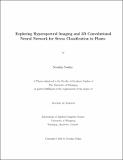| dc.contributor.author | Noshiri, Nooshin | |
| dc.date.accessioned | 2023-12-18T21:01:53Z | |
| dc.date.available | 2023-12-18T21:01:53Z | |
| dc.date.issued | 2023-12-06 | |
| dc.identifier.citation | Noshiri, Nooshin. Exploring Hyperspectral Imaging and 3D Convolutional Neural Network for Stress Classification in Plants; A Thesis submitted to the Faculty of Graduate Studies of The University of Winnipeg in partial fulfillment of the requirements of the degree of Master of Science ... [in] Applied Computer Science. Winnipeg, Manitoba, Canada: University of Winnipeg, 2023. DOI: 10.36939/ir.202312181457. | en_US |
| dc.identifier.uri | https://hdl.handle.net/10680/2127 | |
| dc.description.abstract | Hyperspectral imaging (HSI) has emerged as a transformative technology in imaging, characterized by its ability to capture a wide spectrum of light, including wavelengths beyond the visible range. This approach significantly differs from traditional imaging methods such as RGB imaging, which uses three color channels, and multispectral imaging, which captures several discrete spectral bands. Through this approach, HSI offers detailed spectral signatures for each pixel, facilitating a more nuanced analysis of the imaged subjects. This capability is particularly beneficial in applications like agricultural practices, where it can detect changes in physiological and structural characteristics of crops. Moreover, the ability of HSI to monitor these changes over time is advantageous for observing how subjects respond to different environmental conditions or treatments. However, the high-dimensional nature of hyperspectral data presents challenges in data processing and feature extraction. Traditional machine learning algorithms often struggle to handle such complexity. This is where 3D Convolutional Neural Networks (CNNs) become valuable. Unlike 1D-CNNs, which extract features from spectral dimensions, and 2D-CNNs, which focus on spatial dimensions, 3D CNNs have the capability to process data across both spectral and spatial dimensions. This makes them adept at extracting complex features from hyperspectral data. In this thesis, we explored the potency of HSI combined with 3D-CNN in agriculture domain where plant health and vitality are paramount. To evaluate this, we subjected lettuce plants to varying stress levels to assess the performance of this method in classifying the stressed lettuce at the early stages of growth into their respective stress-level groups. For this study, we created a dataset comprising 88 hyperspectral image samples of stressed lettuce. Utilizing Bayesian optimization, we developed 350 distinct 3D-CNN models to assess the method. The top-performing model achieved a 75.00\% test accuracy. Additionally, we addressed the challenge of generating valid 3D-CNN models in the Keras Tuner library through meticulous hyperparameter configuration. Our investigation also extends to the role of individual channels and channel groups within the color and near-infrared spectrum in predicting results for each stress-level group. We observed that the red and green spectra have a higher influence on the prediction results. Furthermore, we conducted a comprehensive review of 3D-CNN-based classification techniques for diseased and defective crops using non-UAV-based hyperspectral images. | en_US |
| dc.description.sponsorship | MITACS | en_US |
| dc.language.iso | en | en_US |
| dc.publisher | University of Winnipeg | en_US |
| dc.rights | info:eu-repo/semantics/openAccess | en_US |
| dc.subject | Hyperspectral imaging | en_US |
| dc.subject | 3D Convolutional neural networks | en_US |
| dc.subject | Bayesian optimization | en_US |
| dc.subject | Keras Tuner | en_US |
| dc.subject | Spectra | en_US |
| dc.subject | Channel importance | en_US |
| dc.subject | Lettuce | en_US |
| dc.subject | Stress detection | en_US |
| dc.title | Exploring Hyperspectral Imaging and 3D Convolutional Neural Network for Stress Classification in Plants | en_US |
| dc.type | Thesis | en_US |
| dc.description.degree | Master of Science in Applied Computer Science | en_US |
| dc.publisher.grantor | University of Winnipeg | en_US |
| dc.identifier.doi | 10.36939/ir.202312181457 | en_US |
| thesis.degree.discipline | Applied Computer Science | |
| thesis.degree.level | masters | |
| thesis.degree.name | Master of Science in Applied Computer Science | |
| thesis.degree.grantor | University of Winnipeg | |

